Exhibition texts
Dayanita Singh: Dancing with my Camera
“My medium is photography. I twist it and turn it, I wrestle with it – until the form reveals itself to me. That is my work as an artist. To excavate the potentials photography is pregnant with.” — Dayanita Singh
Back to the exhibition
Introduction
Beginning in the 1980s, Dayanita Singh has pioneered a genre-defying approach to photography, one that pushes the limits of the medium. In fact, the artist’s practice traverses media – from images to books that turn into exhibitions and museums, after which they circle back and are reimagined as books again. For Singh, photography is the raw material, a starting point, rather than an end in itself.
This retrospective presents the key works of Singh’s oeuvre, spanning four decades up to her most recent major project, Let’s See (2021). Intimate encounters, movement, music, space and archives are preeminent motifs in Singh’s passage across continents, geographies, people, objects and media.
Trained in visual communication, Singh began her career as a photojournalist. Her first photographic project followed her mentor, the tabla maestro Ustad Zakir Hussain, on tour. Subsequently, Singh has made her viewers fellow travellers on her journey through archives to book-objects and her “museums”. Along the way, we repeatedly meet friends and acquaintances who are portrayed dancing, caressing, playing music or simply looking – often across decades. Throughout, Singh challenges us continually to imagine new, more mobile, accessible and fluid exhibitions, books and images.
Singh’s work liberates the photograph from the wall. This process finds one resolution in her invention of what she terms “museums”. These are large wooden structures that can be opened and rearranged in different configurations, each holding varying images that she describes as “photo-architectures”, and all of which can be folded up and packed away. Singh’s “book-objects” are also exhibitions in themselves, the result of her rigorous and intuitive editing – and at times, she gifts them to friends and acquaintances. They are, in effect, exhibitions that anyone can own, exhibit and archive. Singh therefore also liberates the book from the shelf.
For Singh, every exhibition is portable, always in a state of readiness to be taken anywhere in the world.
Museum of Chance
Dayanita Singh: Dancing with my Camera, 2022. installation view, Museum of Chance (2013)
© Gropius Bau, photo: Luca Girardini
Dayanita Singh conceives of photography as the raw material for her work. She draws perfect circles here: her photographs become a book, which becomes an exhibition, which becomes a catalogue.
Museum of Chance (2013) marks a turning point in Singh’s practice. With it, Singh invented a form that she calls her “museum”. At once a portable museum, photo-architecture and a foldable exhibition, Museum of Chance is the “mother museum” of those presented in the subsequent rooms.
With 163 images taken across three decades, Museum of Chance shows bodies entangled, dancing and moving. We see clothing hanging on racks or rails, and personal cycles of rebirth, storage, recollection and memory.
Each structure, made with hand-built teak panels, is moveable, with wings that open and close. Singh’s museums are at once an archive, storage device and presentation structure for her photographs, enlarged contact sheets and mobile architectures in space.
Singh’s editing process – sorting through contact sheets containing many images – is meticulous and intuitive. She refers to her contact sheets as the heart of her archive, her diary of four decades. Even when she now photographs digitally, she still produces analogue contact sheets to edit the work, then making tiny prints that she hand-cuts and refusing to use the computer until necessary. This is a highly tactile process, which furthers an on-going interest in the connection between human touch and cycles of music, rhythm and movement.
Zakir Hussain
Dayanita Singh revisits people, individual projects and interests. One important early connection is with her mentor, the tabla maestro Ustad Zakir Hussain.
Singh met Hussain in 1981, while she was a student at the National Institute of Design in Ahmedabad. Over the next six winters, Singh documented Hussain, together with several classical musicians, on their annual tours to various cities and small towns in India – Allahabad (Prayagraj), Pune, Dharwad, Bombay (Mumbai), Calcutta (Kolkata), Madras (Chennai) and beyond.
Singh credits Hussain with how she learnt to be an artist, as she observed at close quarters the musician’s riyaaz (rigorous practice) and dhyaan (focus) on his medium.
The result was her very first book, Zakir Hussain: A Photo Essay (1986), which was published by Himalayan Books in New Delhi. One of the few remaining copies is displayed on the wall. The portraits show Hussain with his family including his father, Ustad Alla Rakha, a legendary musician and his guru. They capture the energy of performance and travel, prefiguring Singh’s on-going interest in movement, human relations and the body.
For Singh, the published book is not a supplement to the exhibition, but an exhibition in itself. In 2019, the publishing house Steidl Verlag printed a facsimile of Singh’s handmade maquette, even reproducing all incidental markings and pencilled notes. Zakir Hussain Maquette (2019) comprises the facsimile, the Zakir Hussain Reader and a foldable Zakir Hussain poster. This is the only form in which the work exists; there are no prints.
These works demonstrate Singh’s ability to invent new forms, her abiding interest in mentorship and friendship, and her desire to share special moments with audiences not usually privy to behind-the-scenes intimacies.
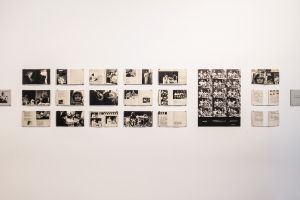
Dayanita Singh: Dancing with my Camera, 2022, installation view, Zakir Hussain Maquette (2019)
© Gropius Bau, photo: Luca Girardini
Museum of Tanpura
Dayanita Singh: Dancing with my Camera, 2022. installation view, Museum of Tanpura (2021)
© Gropius Bau, photo: Luca Girardini
Ever since her 1980s project photographing Ustad Zakir Hussain and classical musicians on tour, Dayanita Singh’s photographs have focused not only on individual figures but on other artistic forms too – architecture, dance and especially music. The photographs in Museum of Tanpura (2021) take us through concert halls, backstage rooms, drawing rooms, hotel rooms, bedrooms and even a Musician’s Bus (2021).
Singh refers to herself as an archivist. While looking at the contact sheets of her early work Singh found these images. She undertook an intensive process of re-archiving, re-selecting and sorting. She terms this key stage in her process “editing” and “listening” to images. Through this activity, Singh has identified a new protagonist in her early project: a drone instrument called the tanpura.
The result is her Museum of Tanpura, presented in three pillars. In Indian classical music, the tanpura does not play a melody, but is a “backbone” setting the tone that is played alongside the solo musician. In Museum of Tanpura, it is identified as a hidden character that stages a consistent mood for the project.
Displayed on the wall, Kishori Tai (2021) was published by Singh’s imprint Spontaneous Books and named after the great Indian classical vocalist Kishori Amonkar. Singh was surprised to find these images, which were made on one Guru Purnima (a day on which scholars pay homage to their gurus) in her archive of musicians. This book-exhibition demonstrates Singh’s process of reinvention through editing, as she returns to individual projects, discovering new characters and protagonists.
The hand-made accordion-book Musician’s Bus is similar in size to Kishori Tai. It uses a range of images from the archive
Mona Ahmed
Two intertwined groups of motifs are present in Dayanita Singh’s art. On the one hand, there is physicality and touch, and on the other there is family, friendship and kinship. These interests come together with a startling intimacy in Singh’s series of works on Mona Ahmed.
Singh met Ahmed in 1989. Ahmed was a transgender person who decided to leave a third gender community in India, choosing to live by herself in a graveyard. The 23 artworks in Mona Montages (2021) derive from the deep connection that Singh forged with a person she called her closest friend and who died in 2017.
In Mona Montages, Mona is shown amid a garland flowers, or dancing. Through her gestures or with her arms, Mona often “frames” her own body for the camera. Mona resists easy representation, and Singh complicates this further by using the technique of montage. In these montages she manually cuts and pastes images of Mona onto prints of other works, such as Privacy (1992–2002), Masterjee (1993/2021) and File Room (2008–2011).
Myself Mona Ahmed (2001) combines photo-book, biography, autobiography and fiction. In Mona Study Table (2001/2021), Ahmed’s personality is both highly photogenic yet oddly resistant to being captured. As such, she is fundamentally free – not least in her relationship to dance. As she once said, “I get this urge to dance from within.”
Completed for this exhibition, Singh’s first Museum of Dance (Mother Loves to Dance) (2021) emerges from the artist’s fascination with movement. The 108 images establish a kinship of figures that have appeared in Singh’s work: Mona Ahmed dancing with her daughter or friends, or in the cemetery where she lived and is now buried; Singh’s mother dancing at weddings; classical Indian dancers, including Birju Maharaj and Kumudini Lakhia; and “Masterji” Saroj Khan’s Hindi cinema choreography.
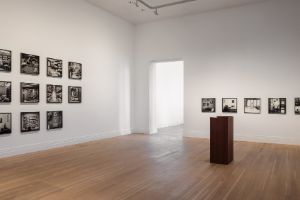
Dayanita Singh: Dancing with my Camera, 2022, installation view, Mona Montages (2021)
© Gropius Bau, photo: Luca Girardini
Sent a Letter
Dayanita Singh: Dancing with my Camera, 2022. installation view, Sent a Letter (2008)
© Gropius Bau, photo: Luca Girardini
The major project Sent a Letter Museum (2008/2021) was an important milestone in Dayanita Singh’s investigation of modular forms, photography and book-objects. Through Sent a Letter (2008), she uncovered one form in which her book became the exhibition. As such, Sent a Letter led directly to Singh’s subsequent “museums”.
Sent a Letter is a handmade cloth box with seven accordion-fold books that unfold to become seven exhibitions. The images in Sent a Letter convey Singh’s travels in 2002 – to Calcutta (Kolkata), Devigarh, Bombay (Mumbai), Allahabad (Prayagraj), Varanasi, Padmanabhapuram – and one book with photographs of Singh taken by her mother Nony Singh.
During these travels, Singh produced photographic journals in Moleskine notebooks, each referencing a specific figure who had accompanied her – visiting a site, a museum or landmark. The photographs in Sent a Letter are at once acts of correspondence and recollection, referring to states of dispersion, wandering and connection implied by travel.
Each book represents a diary, but is also a gift that can be unfolded. The works enact Singh’s move to a form that combines photography with books and, by extension, books and exhibitions. Each intimate work constitutes an exhibition in itself.
Go Away Closer
The now-iconic image of a girl lying on a bed, her face evading the gaze of the camera, sets the tone for Go Away Closer (2007). Its 28 small-format, square photographs represent another milestone in Dayanita Singh’s trajectory. They mark a shift in how she edits her work, as it moved from documentary photography to an intuitive, emotionally attuned assembling and re-assembling of her images.
It was in this series that Singh identified her “editing” process, which she further describes as a way of “listening” to the images. The image of a girl on the bed establishes the key and tonality of the series in the same way that a musician sets the pitch for a singer.
Similarly arresting in their drama, the images in Go Away Closer defer or suppress direct contact: sites and spaces such as an empty auditorium or workshop contain an enigmatic desolation, a withholding of human presence.
Go Away Closer has often been described as a novel without words. In this work, Singh holds a mirror up to the conflicting tonalities of progress and destruction, tradition and innovation, speaking of solitude, departure, memory and loss. Motifs such as the girl on the bed recur in Singh’s Little Ladies Museum 1961–present (2013), and some of the industrial sites in Go Away Closer led to Blue Book (2008).
The diminutive photographs also offer a directive to the viewer – a way to approach the works, a way to interact despite their intensely conveyed sense of intimacy and privacy.
Singh very rarely works in colour. A tangle of roofs and industrial buildings sets the mood for the photographs in Blue Book. An atypical use of hue for Singh, the 15 prints portray a kind of landscape photography in which industrial features and buildings press against the sky. The result of travels to various industrial sites in India, the works have a coolness that is displaced by the use of a blue – taken at moments of dusk, with a haunting sense of erased human presence.
Initially she started the project with black-and-white film. However, making the first photograph at sunset, she decided to use daylight colour film, which she had with her. They turned out to be infused with an exaggerated blue tone. She decided to continue with the colour film as the images perfectly conveyed the melancholic atmosphere of the industrial landscape. Singh often says she only uses colour when it does something more than the colour we can see.
Dayanita Singh: Dancing with my Camera, 2022. installation view, Go Away Closer (2007)
© Gropius Bau, photo: Luca Girardini
I am as I am
Dayanita Singh: Dancing with my Camera, 2022. installation view, I am as I am (1999)
© Gropius Bau, photo: Luca Girardini
Dayanita Singh circles back to sites, spaces and motifs across decades, but she returns especially to specific people. For the twelve prints in I am as I am (1999), Singh returns to an ashram in Varanasi, India. Singh used to visit this place with her family as a child. Years later, when she started making photographs, she returned to the ashram and met Jyoti, a young girl who became a close friend of Singh’s and who she continues to photograph even now.
The ashram in Varanasi is a place of seclusion, a home where girls can determine whether or not they will pursue a life of religious devotion. In these images, Singh manages to portray the intimacy and safety of the space. We sense the privacy that permits the commingling of play and devotion – to spirituality and to each other.
Nearly two decades later, this project served as a prompt for Singh to further develop her idea of “shedding”, which she adapts from a spiritual vocabulary, and refers to a process of refinement through reduction.
Architecture
Dayanita Singh’s interest in architecture arises from her fascination with the effect of light on buildings and vice versa. Rather than fixing her works in a specific time and place, her montages of architectural detail leave an open question: “where and when was this taken?” Freed from temporal and spatial constraints, they can be seen as constructions of imagined spaces using real ones.
Singh’s Architectural Montages (2019–2021) are entirely analogue, hand-cut and pasted by her. They construct a set of family resemblances among differing architectural motifs, from 7th Century architecture in Kyoto to modernist buildings in Sri Lanka, India and Japan.
As extensions of her mobile museums, each pillar comprises of five cubes that can be folded and flattened for easier transport. Corbu Pillar (2021) shows images of pillars in Le Corbusier’s buildings. Bawa Rocks (2020) is a study of the rocks within which the Kandalama Hotel in Sri Lanka was built: rocks touch, unconventionally framed by built architecture. The architect of this hotel, Geoffrey Bawa, is a key figure for Singh, and is present in the neighbouring room via the tribute to him in Box 507 (2019).
BV Stairs (2021) contains another tribute, this time to the Indian modernist architect Balkrishna Vithaldas Doshi. His belief that architecture is a living, changing and fluid entity, depending on need, time and circumstance, contains ideas reflected in Singh’s modular structures and approach to to photography.
Dayanita Singh: Dancing with my Camera, 2022. installation view, Architectural Montages (2019–2021)
© Gropius Bau, photo: Luca Girardini
Box 507/PaintedPhotos
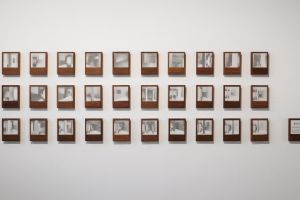
Dayanita Singh: Dancing with my Camera, 2022, installation view, Box 507 (2019)
© Gropius Bau, photo: Luca Girardini
Published by her own imprint, Spontaneous Books, Dayanita Singh’s Box 507 (2019) pays homage to Geoffrey Bawa, the Sri Lankan architect. Bawa’s Kandalama Hotel, nestled within rocks and mountains, it incorporates the specific geography of its site into its semi-interior spaces. Bawa stayed in room 507 when he visited his signature hotel project.
In contrast to the situated nature of static architecture, Box 507 demonstrates Singh’s unique practice of making her book-objects mobile, portable and “unfixed”, enabling viewers to take Singh’s exhibitions home and encouraging them to curate their own exhibitions.
Box 507 is made in an edition of 360. Each teak box contains 30 offset-printed image cards. The collector can change the front card of the edition. In the offset process, Singh has found another way to print her images.
Similarly, for her Painted Photos (2021–2022), Singh overlaid a coat of white paint over images from her archive. A cloudy film now rests upon her original subjects. Through this act, the artist references the overlapping of memory and withholding, as well as the cloth coverings around some of her book-objects. Similarly, Singh has often stored her own museums in her home, protected with white muslin cloth covers so that the images become ghosts of themselves.
Singh writes, “The Painted Photos reduce the images, pare them down to an essence, even a scent, if you will,” adding that “they just become hints of the images.”
Museum of Shedding
With her photo-architecture Museum of Shedding (2016), Dayanita Singh refers to the act of “shedding”, reducing or paring down.
Singh’s works are often modular, referring to mobile, built architecture, and containing frames within frames. Museum of Shedding refers especially to domestic spaces and architectures, containing a large teak structure, a bed, desk, table and stools. This pared-down architecture has a domestic origin: Singh built it so that she could live with it and would be able to show others her work.
Museum of Shedding enacts the division between private and public spaces that runs through Singh’s photographs. On one side of the structure is a partition, beyond which a curator might reside; on the other side, a space is intended for visitors or viewers of her work. The museum contains images of contemporary and classical architecture. Similarly to the other museums, the entire structure can be folded up and packed – emphasising that this domestic structure is in fact portable.
“Shedding” has an architectural meaning for Singh, who is drawn to the way this concept is enacted through architecture, which in turn informed her photographs of architectural motifs and montages in the adjacent room.
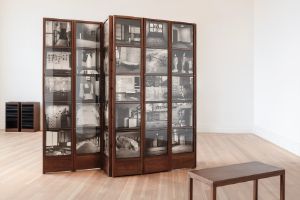
Dayanita Singh: Dancing with my Camera, 2022, installation view, Museum of Shedding (2016)
© Gropius Bau, photo: Luca Girardini
Bookmaking
Dayanita Singh: Dancing with my Camera, 2022. installation view, Museum Bhavan (2017)
© Gropius Bau, photo: Luca Girardini
From her earliest project, Zakir Hussain: A Photo Essay (1986), through to her latest book, Let’s See (to be published by Steidl Verlag), bookmaking has been intrinsic to Dayanita Singh’s work. Referring to herself as an “offset artist”, Singh views offset printing as a literal metaphor, so to speak, one that enables the dissemination of information, images and material. Singh has a unique view on exhibitions: each book does not represent an “original” exhibition but is, in fact, the original exhibition itself. As such, anyone with access to each book can view the exhibition whenever and wherever they are – freeing the exhibition from the specific constraints of the wall and the institution.
Over the years this practice has progressed from the handmade maquette of the Zakir Hussain book into accordion-fold books, bookmuseums and more conventionally bound volumes. It has also resulted in a multi-year artistic collaboration with the Göttingenbased publishing house Steidl Verlag, with whom Singh has published Privacy (2003), Go Away Closer (2007), Sent a Letter (2008), Dream Villa (2010), File Room (2013), Museum of Chance (2014), Museum Bhavan (2017) and Zakir Hussain Maquette (2019). Each of the recent books is at once an exhibition, a portable museum and an original work.
Singh’s “museums” – nine in all – are united and collected as the Museum Bhavan (2017), Hindi for “large gathering space”. Museum Bhavan consists of nine individual book-museums, contained in a handmade box that can be unfolded and installed as and when desired. Each cover of the box is unique.
Pothi Box (2018) is one of Singh’s book-objects published by Spontaneous Books. In this work, a wooden structure, wrapped in fabric, contains an unbound book of 30 image cards, which can be re-sorted as desired. For Singh, it is important that there is no “original single print” other than these boxes, which exist as an edition of 360. That way, the exhibition can be taken home relatively inexpensively, and acquired directly off the wall. When all the boxes are sold, the edition and exhibition have ended, or are complete.
Singh’s books are always on the move, like the Book-cart (2011) or My Life as a Museum (2018), a nine pocket jacket produced in India and dyed with indigo, presented on a hanger.
Both as an object and in what it contains, Suitcase Museum (2015) embodies the forces of dissemination, mobility, motion and access that are key to Singh’s practice. Inside two leather suitcases are 22 book-objects. Each book-object in turn holds a copy of the Museum of Chance book with its 44 different front and back covers, amounting to a total of 44 book-objects within the two suitcases.
Singh’s book-objects and museums can be seen as a challenge to conventions of the museum exhibition form, with its de facto static character. At once a book, a suitcase, an exhibition, an object and a metaphor for portability, each museum suggests one way we can consider a new form for museum architectures beyond the confines of the institution. Yet, the leather suitcases also contain connotations of migration, tourism, travel and displacement, as well as being repositories of memory and history.
File Museum
Dayanita Singh also calls herself an “archivist”. Her works can be seen as a mobile archive of figures, images, impressions and individual formal interests that often recur across decades. In Singh’s works, individual figures and motifs reappear across individual museums.
One of Singh’s most recognisable works is her File Museum (2012). The project marks the beginning of her museum series, in this case with a portable teak sculpture, a form she subsequently established as a preferred medium for her museums. While many of her works have an archival character, in File Museum, Singh most directly photographs archives.
We see papers and bound files, photographed by Singh in India, as well as the custodians of these spaces, all documents of tactility. In many of the works, records and books seem to overflow from their archives. The works carry a tension between order and entropy, between preservation and decay. Interplay between the human form, with its specific individual character, and the attempt at standardisation and preservation inherent in archival spaces is a palpable aspect of this work.
Singh’s image of the girl on the bed (from Go Away Closer, 2007) re-emerges among the 94 images in Little Ladies Museum 1961 – present (2013). We also see photographs of the artist and her siblings throughout their childhood, taken by their mother Nony Singh, as well as portraits taken by Dayanita Singh of various girls and women at different stages of their lives, some of whom she has returned to photograph over the years. For example, we see Jyoti from the ashram in Varanasi, as well as images of Ayesha.
Dayanita Singh: Dancing with my Camera, 2022. installation view, File Museum (2012)
© Gropius Bau, photo: Luca Girardini
Time Measures
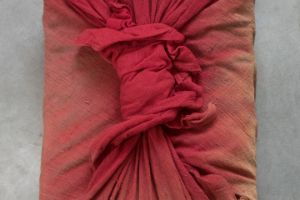
Dayanita Singh, Time Measures (2016)
© Dayanita Singh
“Time measures/Nothing but itself”, the author W. G. Sebald wrote and thus inspired the title of this series. The colour photographs in Time Measures (2016) bridge Singh’s ongoing interest in archives, the motion of time and the personal associations that we have with fabric, with an alternating sense of privacy or withholding featuring in her projects.
In an archive in India, Singh discovered bundles of documents that were wrapped in fabric. They are enigmatic, we do not know their contents and they are tied with a unique knot.
Photographed head on, with a rare use of colour for Singh, the photographs carry a tension between the images’ bright tones and the aged, faded, warped fabric. The images carry an opposition between the repetition of the knots and their individual, almost expressive, uniqueness. As a result, each bundle is both the same and different.
A sense of repetition and rhythm is produced by their hanging, connecting to Singh’s interest in movement and music. The appearance of light imprinted and then faded on cloth is a cue for photography itself with its interplay of light, exposure, time and material.
Mona and Myself
Mona and Myself (2013) is a looping, moving still-image portrait of Mona Ahmed, the same person featured in the and rooms of this exhibition. The moving still image is a document of a figure who was of close personal and artistic interest to Singh.
Mona and Myself is a work that emerged more or less serendipitously, as Singh and Mona Ahmed spent time together in Singh’s studio in 2013. After playing the song “Rasik Balma” sung by Lata Mangeshkar in the Hindi-language film Chori Chori from 1956, Ahmed began to sing. Singh recorded her in this unrehearsed performance. Somewhere between film and photography, the work is one that Singh chooses to project large scale onto the wall, so that Mona Ahmed herself “becomes a landscape”, as Singh remarks.
At once a mood, a landscape and an intimate portrait, Mona and Myself carries a certain deliberate simplicity, as it shows Mona in a state of repose and engagement, just listening to a song and then becoming the song.
Dayanita Singh: Dancing with my Camera, 2022. installation view, Time Measures (2016) and Mona and Myself (2013)
© Gropius Bau, photo: Luca Girardini
Let’s See
Dayanita Singh: Dancing with my Camera, 2022. installation view, Let’s See (2021)
© Gropius Bau, photo: Luca Girardini
During the COVID-19 lockdowns in 2020, Dayanita Singh continued her process of diving deep into her archive of analogue contact sheets – her process of “editing”. She finally found the time to go through her very early work of the 1980s. This editing resulted in an entirely new work and structure, Let’s See (2021), which charts a new way forward for Singh’s practice and is realised for the first time in this retrospective.
These 108 images, across twelve panels, show images from the 1980s. They contain some of Singh’s earliest photographs, most made even before she began to refer to herself as an artist. Typically, before being printed on photo paper and mounted, photographic originals are compiled in sheets containing many images on a single page – this is called a contact sheet. Singh’s panels, in this new structure, reference contact sheets, albeit at enlarged scale. They can be arranged in several ways because the images slide in and out of the structure.
These early photographs, seen today, contain many of Singh’s later trademarks, including the close, yet always enigmatic, representation of figures in states of intimacy. In Let’s See, whose topic may be photography itself, certain leitmotifs emerge including human connection through rituals relating to hair, bodies entangled or touching one another in various poses of affection or states of repose, which are reminiscent of dance.
Musical interests, such as in the tanpura – a drone instrument in Indian classical music – combine with Singh’s interest in movement, transformation and touch. All are accomplished within a precise if candid-seeming photographic act. Let’s See reveals the seeds of many of Singh’s later works and protagonists.